Estado de Durango large-numeral 1-centavo, Later Series
by David Hughes
The similarities (improved quality of the lettering, layout and design) between the large-numeral 1-centavo and 5-centavo, suggest these dies were designed, cut and used at the same time, at a lower relief than previous, prepared by a different engraver, late in the series. Letter design that had not previously appeared in Durango was used. These coins were probably the last pieces actually struck in Durango. Dies improved, but strike did not—as Neil Utberg would say, “AA” (About Awful) and not often better. Amaya notes “Nevertheless, we have to wait and see if we can obtain better-preserved pieces so we can identify them with more scrutiny.”
Speculation on the possible origin of the large-numeral Durango dies
General Francisco “Pancho” Villa, in effective control of the state of Chihuahua by early 1914, was delighted with the Cuencame, Durango Muera Huerta (Death to Huerta) peso, and sent five of them to Victoriano Huerta in Mexico CitySAICO, 1963, with his compliments, probably hoping Huerta would die from a stroke of apoplexy.
WoodHowland Wood, The Mexican revolutionary coinage, 1913-1916. The American Numismatic Society, New York, 1921 (available in the USMexNA online library) suggested that the later issues of the 1914 Muera Huerta peso were struck at the Chihuahua mint. Observations that the edge reeding on the pattern 1914 Chihuahua copper peso (GB-71), the 1915 Army of the North silver peso (GB-72), and the c.1915 Sevilla-Villa medal does not match the reeding on the Muera Huerta peso (6-star and later issues), suggests the Muera Huerta was not struck in Chihuahua. There is, however, no doubt about the difference in engraving between the 6-star Muera Huerta GB-84 and the later issues of GB-86/87. A totally different engraver was involved.
Considering the old story that the Chihuahua mint was involved, the engraving, and the probable desire of Villa for an extensive coinage, I suggest he had dies prepared at the Chihuahua mint and sent them to Cuencame, Durango, where the 6-star was struck. The combination of the old 6-star eagle die (in a very late die state, from Cuencame) with the new Liberty cap die (an import from Chihuahua?) suggests a die trial.
Therefore, back in the city of Durango, observing:
- Rather crude dies and variances (many) in die style, design, layout, and lettering, in the first issue ESTADO DE DURANGO 1-centavo and the subsequent E. DE DURANGO 5-centavo,
- Very similar diework within the later, nicely laid out and engraved ESTADO DE DURANGO large-numeral 1-centavo and 5-centavo series, suggesting a different engraver,
- Similar numerals and characters, especially the 4 (on the 5-centavo), E(s) and T(s), between the later MUERA HUERTA die and the Durango large-numeral dies, suggesting the new engraver cut both sets of dies,
I suggest the large-numeral 1-centavo and 5-centavo dies for Durango may also have been prepared at the Chihuahua mint. From this great time and distance, it certainly appears the Chihuahua mint had better tooling and engravers. Four pair of 1-centavo dies and two pair of 5-centavo dies were prepared.
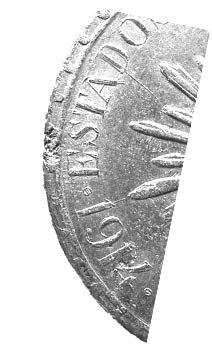
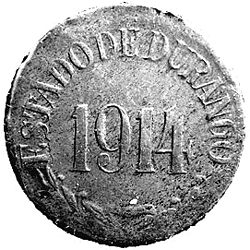
Lettering comparison, later Muera Huerta peso and Durango large-numeral 5-centavo
Similar, nicely-shaped letters, a striking resemblance, suggesting the same engraver using good tools.
The presence of 1-centavo “Mint Sports” suggests the 1-centavo was being struck during the mint closing. Enthusiasm and oversight were leaving the building. The 1-centavo obverse dies and combination varieties are often difficult to identify. Four obverse dies and four reverse dies, two previously undescribed, are noted for the 1-centavo, forming at least five die combinations in seven confirmed varieties, with 1-centavo mint sports resulting in additional varieties.
Large-numeral 1-centavo Obverse Dies (9-12)
Four distinct obverse dies (9-12) are recognized. Recognized is perhaps not quite the right word to use, as these can be difficult to type due to low relief, poor strike, poor planchet, misaligned dies, actual circulation wear, and ancient crud. Many of the identifying features are located in the low-relief lettering near the rim, which is usually poorly developed in these Durango strikes. Comparison against other types helps.
Obverse Die 9 (GB-95)

- A of ESTADO is shaded on the right
- Ball on tail of 9 not even with outside edge of 9, but is inside (more than die 11)
- Topbar of T is centered on the vertical stroke
- Crosslet of 4 tips to the left
(Photograph courtesy of Howard Spindel (ShieldNickels.net))
Obverse Die 10 (so-called GB-95.5)
- A of ESTADO is shaded on the left
- D of ESTADO is lower than A
- Topbar of T of ESTADO is very short on the left (key detail)
- Ball on tail of 9 is even with outside edge of 9
- Base of first 1 lower than base of 9
- Distinct top right serif on second 1
This is one of the two dies of GB-99.
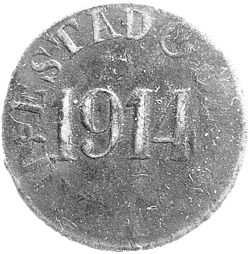
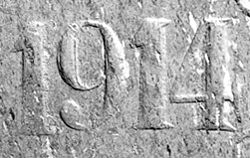
A second example of obverse die 10, and date detail
Note extended serif on top right of second 1. Later die states of this die have a die crack between the 4 and D of DE (present, but hard to see, in the upper photograph). Crack becomes more prominent with age. Latest die state also has a vertical die crack below the second 1.
Obverse Die 11 (so-called GB-95.7)
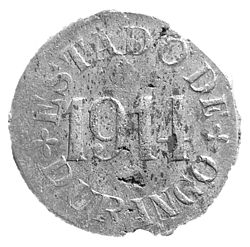
- A of ESTADO shaded on right
- Topbar of T in ESTADO is slightly right of center (not as much as die 10)
- First numeral 1 touches D of DURANGO
- Large oval in 9, little space between oval and ball of 9
- Ball on tail of 9 slightly inside edge of 9
This is the other obverse die of GB-99. Coins struck with this die are rare. An Above Average strike on a Below Average planchet.
Obverse Die 12 (GB-96)
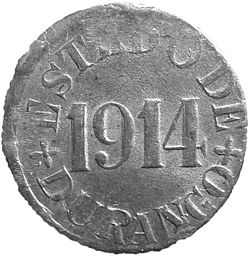
- A of ESTADO is shaded on the left
- Topbar of T in ESTADO is centered on the vertical stroke
- Ball on tail of 9 even with the outside edge of the 9
- S is undersize relative to the E and T
- Base of first 1 lower than base of 9
Guthrie was in error when he stated this die was used on the GB-99 striking.
Large-numeral 1-centavo Reverse Dies (J-M)
Four distinct reverse dies (J-M) are noted. Two of these dies do not appear to have been previously described. So-called GB-95.5 is usually described as “reverse of GB-95” (reverse die J). However, the reverse die of GB-95.5 (die K) is a distinct, separate die, and does not appear to have been previously described in the numismatic literature. It has been known as different for some time (Joe Flores). So-called GB-95.7 (reverse die L) appears undescribed, unknown and rare. These three dies have previously been lumped together as “GB-95 reverse”.
Reverse Die J (GB-95)

- Berry to right of plain numeral 1, between second and third set of leaves from the top
- Oval period after CENT
- The left edge of the numeral 1 approximately bisects the vertical stroke of the E
(Photograph courtesy of Scott Doll)
Reverse Die K (so-called GB-95.5)
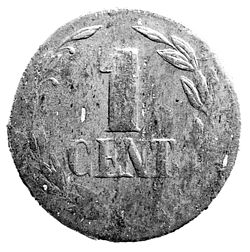
- No berry to right of plain numeral 1 (key detail)
- Numeral 1 has faint vertical shading, head of 1 outlined (unfinished?)
- E and N touch at bottom serif, almost touch at top serif (top serif of E is weak)
- The left edge of the numeral 1 is even with the right edge of the vertical stroke of the E.
This die does not appear to have been previously described separate from GB-95 reverse die J, although it has been known as different for some time (Joe Flores).
Reverse Die L (so-called GB-95.7)
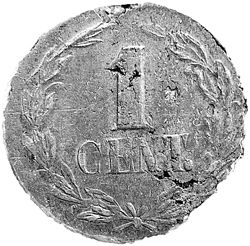
- Berry to right of plain numeral 1
- Top of CENT is not square to the 1, but slants up on the right
- ENT taller than C
- Upper serif of C overhangs the lower serif (buck-tooth C)
- Roundish period after CENT
- Short topbar on T, little space between serifs and vertical stroke
This die has not been previously described. There is a die crack through the upper left wreath. This die is rare, and may have failed early from die breakage. An Above Average strike on a Below Average planchet.
Gaytan reverse die N?
A second variety of the shaded numeral 1 die is reported (not pictured) by Gaytan (1969), as G-DGO-13a, having 6 bars in the head of the 1.
Reverse Die M (GB-96)

- Numeral 1 is shaded horizontally
- 7 bars in head of 1 (including top and bottom bar of head)
- Die defect or tool mark between the bottom left of the numeral 1 and the top left of the E in CENT
- Oval period after CENT
Large-numeral 1-centavo Die Combinations
Five die combinations in this series are known:
- (9/J): GB-95, copper, common
- (10/K): So-called GB-95.5 in copper, common, also in lead. The reverse die is different from GB-95. Sometimes this combination is called “GB-96.5, obverse of 96”, but obverse is also different from GB-96.
- (11/L): So-called GB-95.7 in copper, rare. This piece (x-Stoddard, Woodworth, Flores) does not appear to have been previously described. The author would like to learn of other examples of this die combination.
- (12/M): GB-96 in copper, common, GB-97 in lead
- (10/M): Utberg U-DUR-12, GB-UNL, copper. Seldom-seen, thought possibly an error on Utberg’s part, Joe Flores confirmed the existence of this rare variety with the distinctive very-short-on-the-left topbar of the T Flores, 2001.
Four large-numeral 1-centavo varieties have been reported in lead{Footnote}Long, 1996.

